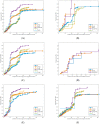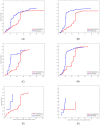Comparison of Secondary Prevention Following Hysteroscopic Adhesiolysis in the Improvement of Reproductive Outcomes: A Retrospective Cohort Study
- PMID: 38202080
- PMCID: PMC10779651
- DOI: 10.3390/jcm13010073
Comparison of Secondary Prevention Following Hysteroscopic Adhesiolysis in the Improvement of Reproductive Outcomes: A Retrospective Cohort Study
Abstract
Intrauterine adhesion (IUA) is primarily caused by endometrial injury, and hysteroscopic adhesiolysis is presently the main treatment. However, postoperative recurrence and poor pregnancy outcomes remain intractable. In this study, we aim to assess the effects of different treatments on clinical symptoms and reproductive outcomes in IUA. This retrospective study was conducted in a tertiary university-affiliated women's hospital. The study included 1449 consecutive women who desired to have a baby and were diagnosed with IUA through hysteroscopy from January 2016 to December 2021. Patients with IUA underwent hysteroscopic electric resection (E) or cold scissors separation (C), as well as hormone therapy and one or both of the following secondary prevention measures: intrauterine devices (IUD) and hyaluronic acid gel (HA). The pregnancy rate (PR) was significantly higher in the E + IUD + HA (90.23% CI: 85.82, 94.64%) than in other groups (p = 0.000) groups. The rates of full-term birth (p = 0.000) and live birth (p = 0.000) were significantly higher in the E + IUD + HA (67.82% and 68.97%, respectively) and E + HA (62.41% and 63.91%, respectively) groups. Multivariate logistic regression analysis revealed a significantly higher PR in women who received second-look hysteroscopy (OR 1.571, 95% CI: 1.009-2.224, p = 0.013) and E + IUD + HA (OR 4.772, 95% CI: 2.534-8.987, p = 0.000). Combining hysteroscopic electric resection with IUDs and HA gel could prevent adhesion recurrence and improve postoperative pregnancy and live birth outcomes in IUA. Furthermore, postoperative second-look hysteroscopy may increase the PR and shorten the waiting period.
Keywords: hyaluronic acid gel; hysteroscopic adhesiolysis; intrauterine adhesion; intrauterine devices; pregnancy rates.
Conflict of interest statement
The authors declare no conflict of interest.
Figures



References
-
- Hooker A.B., Lemmers M., Thurkow A.L., Heymans M.W., Opmeer B.C., Brolmann H.A., Mol B.W., Huirne J.A. Systematic review and meta-analysis of intrauterine adhesions after miscarriage: Prevalence, risk factors and long-term reproductive outcome. Hum. Reprod. Update. 2014;20:262–278. doi: 10.1093/humupd/dmt045. - DOI - PubMed
Grants and funding
LinkOut - more resources
Full Text Sources
Research Materials

